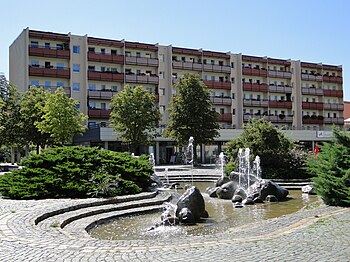Gruna (Dresden)
|
Gruna with Strehlen-Nordost Statistical district No. 57 of Dresden |
|
|---|---|
| Coordinates | 51 ° 2 '5 " N , 13 ° 47' 12" E |
| height | 115 m above sea level NN |
| surface | 1.94 km² |
| Residents | 13,189 (Dec. 31, 2013) |
| Population density | 6798 inhabitants / km² |
| Incorporation | Apr 1, 1901 |
| Post Code | 01277 |
| prefix | 0351 |
| Website | www.dresden.de |
| Borough | Blowjoke |
| Transport links | |
| tram | 1, 2 |
| bus | 61, 63, 64, 74, 85 |
Gruna is a district of Dresden in the Blasewitz district . Gruna is located in the east of Dresden in the immediate vicinity of the Great Garden . The center is Zwinglistraße with a central stop (tram: lines 1 and 2, bus: lines 61, 64 and 85), library, shops and restaurants. On the one hand, the district is strongly characterized by GDR prefabricated buildings (Rosenbergstrasse, Calvinstrasse, Papstdorfer Strasse, Wiesenstrasse) and buildings from the 1990s (Zwinglistrasse), on the other hand there are streets with old buildings, for example from the turn of the century (Beilstrasse, Herkulesstrasse).
The Gruna district differs from the Gruna district in particular in the detailed borderline (Karl-Roth-Straße, Eibenstocker Straße, Bärensteiner Straße). The area between Winterbergstrasse and the Děčín – Dresden-Neustadt railway line is largely part of the Strehlen district.
location
Gruna borders the Striesen district in the north and Seidnitz in the east . Strehlen is to the south of Gruna and Seevorstadt-Ost / Großer Garten to the west .
history
The village of Gruna was first mentioned in a document in 1370. The name means place in the green meadow . The place extends between two oxbow lakes of the Elbe . Field names like Alte Elbe and Blanschfeld are reminiscent of this . The southern Elbarm between today's Bodenbacher Strasse and Winterbergstrasse led to the Great Garden and from there to the Bürgerwiese . The northern one, which is still about two meters lower than its surroundings today, led to Frauensteiner Platz. In 1309, German settlers dug the land ditch in this oxbow lake . Next to the bridge over the Landgraben, a forge was built called the Green Meadow . This name carried over to a neighboring tavern.
After the Dohna castle was destroyed in the course of the Dohna feud , the old Pirnaer Landstrasse (now Bodenbacher Strasse) developed into the most important traffic route to Bohemia .
Gruna belonged to the Reformation to the Bishopric of Meissen . After that it was subordinate to the religious office of the Dresden Council and the electoral office . When the Great Garden was laid out in 1676, Gruna farmers had to give up fields for it. In 1813 the village burned down in the battle for Dresden . The residents were allowed to use building material from the destroyed walls of the Great Garden for reconstruction.
The Gruna children attended school in neighboring Striesen until 1865 , when a schoolhouse was built on Bodenbacher Strasse. This was expanded in 1884.
The number of inhabitants quadrupled in the years from 1867 to 1890. Until the construction of the St. Thomas Church , Gruna was parish to the Kreuzkirche . Gruna was incorporated into Dresden on April 1, 1901 . At that time, the spatially separated Neugruna also belonged to the Grunaer Flur, but later passed to Blasewitz .
After the First World War, numerous residential buildings were built in Gruna and changed the rural character of the settlement. The Bauverein Gartenheim established the garden home settlement between Junghansstrasse and Landgraben in the 1920s . To the east of the ditch, the Dresden savings and construction association was built . The listed GEWOBAG estate , which was built in 1928, is located on Falkensteinplatz and on Zwingli- and Haenel-Clauß-Straße .
During the Second World War, a home flak battery was set up on Liebstädter Strasse from 1943 to 1944 . A memorial today reminds of this. The air raids on Dresden in World War II mainly damaged the village center and the area around Falkensteinplatz. Reconstruction began in 1949 and was completed in the 1960s. The remains of old grass were removed when the high-rise buildings on Rosenbergstrasse were built in the 1970s.
Culture and sights
Sights include the neo-Romanesque St. Thomas Church, the Rothermundtpark , the Hans-Erlwein-Gymnasium , which was built in 1913 (formerly the Dresden-Gruna Gymnasium, architect Hans Erlwein ) and the Foundlingsbrunnen. The fountain festival, which has been held annually in June since 2004, established itself as the Gruna district festival.
The Schieferburg children's and youth center was built on Liebstädter Strasse in 1996 in the style of organic architecture .
A private collotype workshop museum is located in the Dresden printing house on Bärensteiner Straße.
Personalities
- Bartolomeo Bosco (1793–1863), Italian magician, lived in Dresden and Gruna
- Johann Friedrich Wilhelm Wegener (1812–1879), animal and landscape painter of the Romantic era , died in Gruna
- Else Seifert (1879–1968), architecture photographer
- Käte Basarke (1902–1979), photographer , after 1945 atelier at Beilstrasse 14
Economy and Infrastructure
The Radebeul shoe factory was founded in 1916 as the F. Keyl shoe factory in Gruna until it moved to Radebeul in 1925.
The most important roads are the east-west running magistrals Bodenbacher Straße and Winterbergstraße and the north-south axis Zwinglistraße.
See also
literature
- Stadtlexikon Dresden A-Z . Verlag der Kunst, Dresden 1995, ISBN 3-364-00300-9 .
Web links
- Entry on Gruna at dresdner-stadtteile.de
- dresden.de: Statistics (PDF; 354 kB)
- Gruna in the Digital Historical Directory of Saxony








